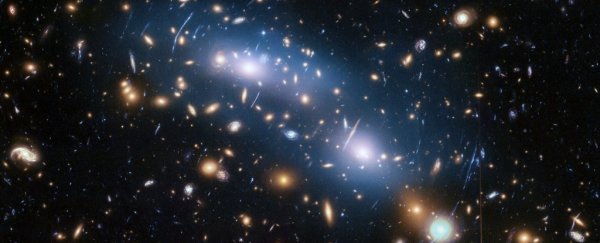Astronomers don't know exactly when the first stars formed in the Universe because they haven't been observed yet. And now, new observations from the Hubble Space Telescope suggest the first stars and galaxies may have formed even earlier than previously estimated.
Why? We *still* haven't seen them, even with the best telescope we've got, pushed to its limits.
A group of researchers used Hubble to look back in time (and space) as far as it could see, hoping to study these first generation of stars of the early Universe, which are called Population III stars.
Hubble peered and squinted back to when the Universe was just 500 million years old – which is thought to be Hubble's limit — and found no evidence of these very first stars.
The name — Population III – is a little confusing. Shouldn't these first stars be called Population I stars? Let's face it, astronomers have never been great about naming things.
The name Population I had already been taken when astronomers classified the stars of the Milky Way as Population I (stars like the Sun, which are rich in heavier elements). Then, the name Population II was used to classify older stars in the Milky Way with a low heavy-element content.
And that left the name Population III to classify the stars that were forged from the primordial material that emerged from the Big Bang, approximately 13.8 billion years ago.
Population III stars must have been made solely out of hydrogen, helium and lithium, the only elements that existed before processes in the cores of these stars could create heavier elements, such as oxygen, nitrogen, carbon and iron.
Rachana Bhatawdekar of the European Space Agency led this most recent study, probing the early Universe from about 500 million to 1 billion years after the Big Bang.
They studied the star cluster MACSJ0416 (see earlier comment about astronomers naming nomenclature) and the surrounding field with the Hubble Space Telescope, along with using supporting data from NASA's Spitzer Space Telescope and the ground-based Very Large Telescope of the European Southern Observatory).
 Illustration of the depth by which Hubble imaged galaxies in prior Deep Field initiatives, in units of the Age of the Universe. (NASA and Feild)
Illustration of the depth by which Hubble imaged galaxies in prior Deep Field initiatives, in units of the Age of the Universe. (NASA and Feild)
These observations were part of Hubble's Frontier Fields program, which observed six distant galaxy clusters from 2012 to 2017, and produced the deepest observations ever made of galaxy clusters and the galaxies located behind them.
This was achieved by using the gravitational lensing effect, where the masses of foreground galaxy clusters are large enough to bend and magnify the light from the more distant objects behind them. This allows Hubble to use these cosmic magnifying glasses to study objects that are beyond its nominal operational capabilities.
These observations revealed galaxies between 10 to 100 times fainter than any previously observed.
Bhatawdekar and her team developed a new technique that removes the light from the bright foreground galaxies that constitute these gravitational lenses.
This allowed them to discover galaxies with lower masses than ever previously observed with Hubble, at a distance corresponding to when the Universe was less than a billion years old.
"We found no evidence of these first-generation Population III stars in this cosmic time interval," said Bhatawdekar.
"These results have profound astrophysical consequences as they show that galaxies must have formed much earlier than we thought."
Since these observations are at the limits of Hubble, it puts one more task on the to-do list for the upcoming James Webb Space Telescope.
This article was originally published by Universe Today. Read the original article.
